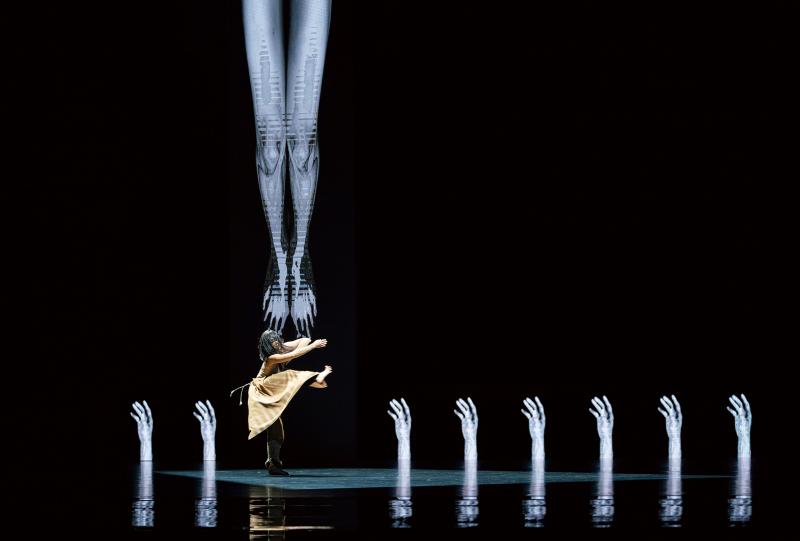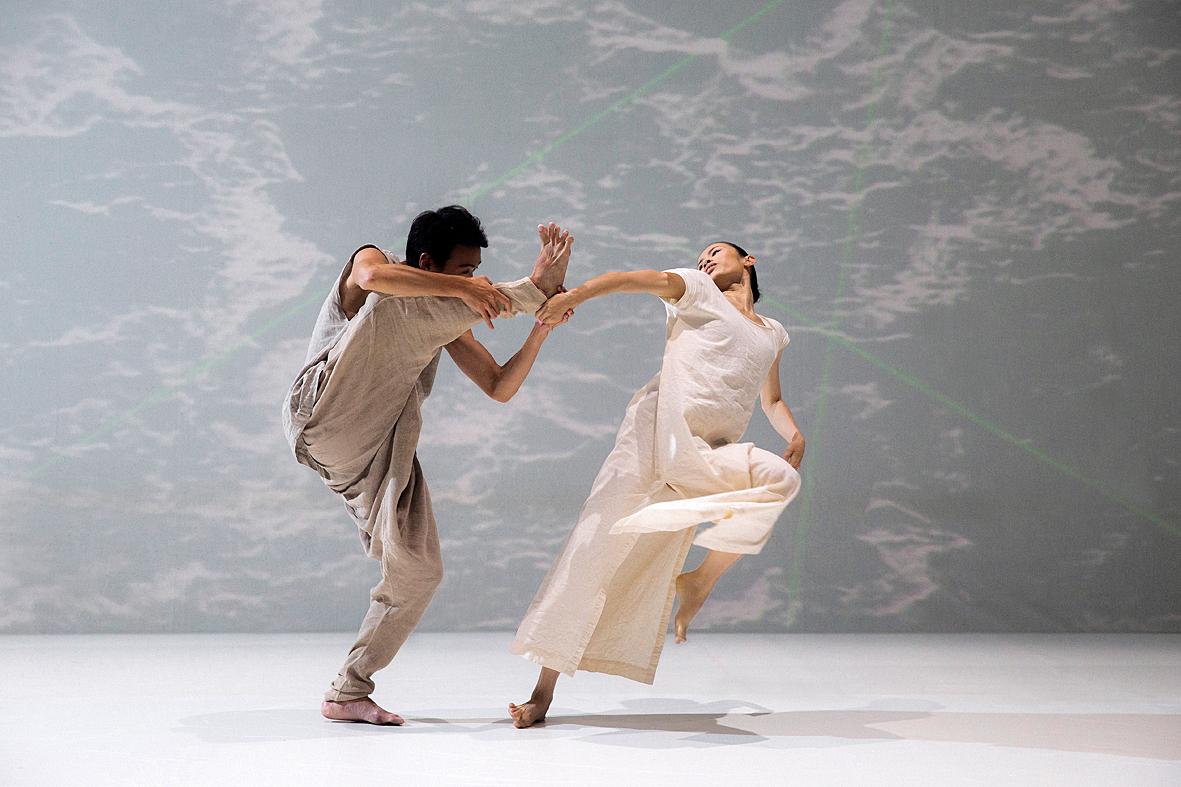Like so many other rites of passage that have fallen by the wayside in this COVID-19 ravaged year, Cloud Gate Dance Theatre of Taiwan’s (雲門舞集) traditional summertime outdoor performances at Taipei’s Liberty Plaza and elsewhere around the nation have been canceled.
It is not that Cloud Gate and its long-time sponsor Cathay Financial Holdings did not believe that they could run a tightly organized show tomorrow night with audience members seated in appropriate social distancing arrangements for what would have been their 25th annual Cathay Arts Festival production.
They were certainly not anticipating a crowd of the size of the 50,000 that showed up on July 27 last year for the 45th Anniversary Gala Program to have a chance to see several senior dancers who were going to be retiring along with company founder and artistic director Lin Hwai-min (林懷民) at the end of last year — or even the 20,000 to 30,000 who have shown up in previous years.

Photo courtesy of Chang Chen-chou
With their well-trained staff and volunteers, Cloud Gate and Cathay Financial could have kept track of who was seated where, just as theaters have been doing for indoor performances, with audience members providing contact information, but the concern was about the people who would be milling about on the fringes of the seating area.
So the decision was made to turn this year’s festival into a digital premier, not of just one production, but two, and not just in Taiwan, but globally.
Starting tomorrow night at 8pm (GMT+8) via Cloud Gate’s, Cathay’s and the Public Television Service’s (PTS) YouTube channels, Lunar Halo (毛月亮), created for Cloud Gate 2 (雲門 2) by its then-artistic director Cheng Tsung-lung (鄭宗龍) will air, followed by Lin Hwai-min: A Retrospective.

Photo courtesy of Liu Chen-hsiang
While Cheng’s Lunar Halo will only be available for 24 hours, the Lin retrospective will remain online for seven days, until Saturday next week at 8pm.
Lunar Halo is an apt choice for a digital audience, as it explores human existence in an ever-changing digital world, questioning the need for physical bodies and senses when so many people now rely on their eyes and fingertips to experience games, films and the world.
Set to an ethereal soundtrack by Icelandic post-rock band Sigur Ros, the dancers move through a landscape of human body parts and color projections, presented on three massive LED screens through the technical and creative wizardry of visual designer Jam Wu (吳耿禎) and videographer Ethan Wang (王奕盛).

Photo courtesy of Liu Chen-hsiang
The dancers morph along with the video projections, creating beautiful images that are often equally intellectually and emotionally challenging.
Lunar Halo is also a good introduction to Cheng, Lin’s successor as Cloud Gate artistic director, for those who have not seen his work for Cloud Gate 2 and other companies. It also serves as a preview of his first full-length production for the reformatted company, Sounding Light (定光), which premieres Oct. 1 at the National Theater before going on tour to Kaohsiung and Taichung.
The Lin retrospective is basically the 45th Anniversary Gala Program, which premiered at the National Theater in November 2018, featuring the company’s dancers in some of their favorite roles of the past two decades, including 1997’s Portrait of the Families (家族合唱), 1998’s Moon Water (水月), 2001’s Cursive (行草) and Bamboo Dream (竹夢), 2006’s Wind Shadow (風.影) and 2013’s Rice (稻禾).
The programs can be viewed on Cloud Gate’s YouTube channel (cloudgate2020.piee.pw/T6HQ9), the troupe’s Vimeo (cloudgate2020.pse.is/SVG79), Cathay Financial’s YouTube channel(cathaylifecloudgate.piee.pw/QWSF4) and PTS’ YouTube channel (lihi1.com/xRejF).
Meanwhile, the second half of the Cathay Arts Festival — Dancing with Cloud Gate — will be held on weekends from Aug. 1 to Aug. 30, in Taoyuan, Hsinchu, Chiayi and Pingtung, and on Friday, Sept. 4 in Taitung.
Curated by Cheng, the program is designed to break down the barriers between performers and audiences by allowing people to interact with the company’s dancers in a variety of public spaces.
Admission is free, but limited due to safety issues and space restrictions. Advanced registration is required for all performances except for those in Chiayi.
More information is available in Mandarin and English on Cloud Gate’s Web site (www.cloudgate.org.tw).

April 7 to April 13 After spending over two years with the Republic of China (ROC) Army, A-Mei (阿美) boarded a ship in April 1947 bound for Taiwan. But instead of walking on board with his comrades, his roughly 5-tonne body was lifted using a cargo net. He wasn’t the only elephant; A-Lan (阿蘭) and A-Pei (阿沛) were also on board. The trio had been through hell since they’d been captured by the Japanese Army in Myanmar to transport supplies during World War II. The pachyderms were seized by the ROC New 1st Army’s 30th Division in January 1945, serving

The People’s Republic of China (PRC) last week offered us a glimpse of the violence it plans against Taiwan, with two days of blockade drills conducted around the nation and live-fire exercises not far away in the East China Sea. The PRC said it had practiced hitting “simulated targets of key ports and energy facilities.” Taiwan confirmed on Thursday that PRC Coast Guard ships were directed by the its Eastern Theater Command, meaning that they are assumed to be military assets in a confrontation. Because of this, the number of assets available to the PRC navy is far, far bigger

The 1990s were a turbulent time for the Chinese Nationalist Party’s (KMT) patronage factions. For a look at how they formed, check out the March 2 “Deep Dives.” In the boom years of the 1980s and 1990s the factions amassed fortunes from corruption, access to the levers of local government and prime access to property. They also moved into industries like construction and the gravel business, devastating river ecosystems while the governments they controlled looked the other way. By this period, the factions had largely carved out geographical feifdoms in the local jurisdictions the national KMT restrained them to. For example,

The remains of this Japanese-era trail designed to protect the camphor industry make for a scenic day-hike, a fascinating overnight hike or a challenging multi-day adventure Maolin District (茂林) in Kaohsiung is well known for beautiful roadside scenery, waterfalls, the annual butterfly migration and indigenous culture. A lesser known but worthwhile destination here lies along the very top of the valley: the Liugui Security Path (六龜警備道). This relic of the Japanese era once isolated the Maolin valley from the outside world but now serves to draw tourists in. The path originally ran for about 50km, but not all of this trail is still easily walkable. The nicest section for a simple day hike is the heavily trafficked southern section above Maolin and Wanshan (萬山) villages. Remains of